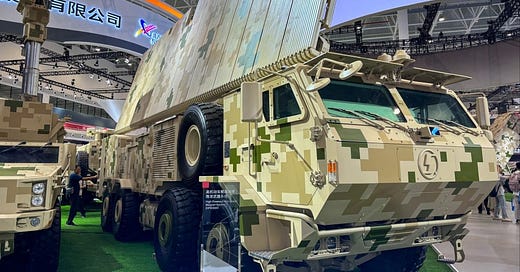China’s High-Power Microwave Weapon and the Illusion of U.S. Technological Superiority.
Not brought to you by the US military Industrial complex.
Reading an article about this I asked perplexity AI to explain it to me and to add what Andre Martyanov might say and what he has said about the US military. My eyes were opened when I read his book, Losing Military Supremacy, a few years ago. I've also read the books that followed.
I share perplexities response (after I poked at it a bit) here.
China's 10,000-Shot Microwave Weapon: A Tactical and Strategic Breakthrough
Recent Developments (April–May 2025)
China’s Northwest Institute of Nuclear Technology (NINT) has achieved a landmark in directed-energy warfare with its compact high-power microwave (HPM) weapon, successfully tested to fire over 10,000 pulses without failure. This system, smaller than a Gatling gun and powered by a 3-gigawatt pulsed current, uses advanced vacuum-sealing and phased-array transmission to disable drones, missiles, and satellites by frying their electronics. The breakthrough, peer-reviewed in High Power Laser and Particle Beams, resolves historic durability and miniaturization challenges, positioning China ahead in the global HPM arms race.
Key Technical Advancements
Vacuum Stability: Ceramic-metal welding and non-evaporable getter (NEG) pumps maintain near-perfect vacuum conditions, preventing energy leakage and component degradation.
Phased-Array Steering: Electronically directs beams without mechanical movement, enabling rapid multi-target engagement.
Energy Efficiency: Operates at 96.6% efficiency, with a self-contained power source reducing reliance on external generators.
Operational Deployment: Hurricane Systems
At the 2024 Zhuhai Airshow, China unveiled two truck-mounted HPM systems:
Hurricane 2000: Light armored vehicle-mounted, 2 km range, targets drones and munitions.
Hurricane 3000: Larger 8×8 truck system with a 3 km range, designed to counter drone swarms and low-orbit satellites.
Recent field tests confirmed the Hurricane-3000’s ability to disable UAVs mid-flight, creating a "hemispherical mosquito net" of protection against saturation attacks. NORINCO (China’s defense contractor) claims the system’s microwave beams are 10,000x more powerful than household microwaves, burning out electronics at near-light speed.
Strategic Implications
1. Countering U.S. Drone Swarms
The U.S. Replicator Initiative aims to deploy thousands of drones by 2026, but China’s HPM systems offer a cost-effective solution. Each HPM shot costs ~$100 in electricity vs. $4.2M per SM-6 interceptor.
2. Electronic Warfare Dominance
The weapon’s EMP-like pulses could degrade U.S. communications networks (e.g., Starlink) and blind carrier strike groups, aligning with China’s anti-access/area-denial (A2/AD) strategy.
3. Export Potential
China’s vertical integration (e.g., gallium production) and affordable pricing make HPM systems attractive to allies, undermining U.S. defense exports.
Andrei Martyanov’s Perspective: "The American Scam"
Martyanov, author of Losing Military Supremacy, would likely frame this development as evidence of U.S. military-industrial decay. His critiques align with three key contrasts:
Aspect China’s HPM U.S. Counterparts
Cost Efficiency ~$100/shot; $500K system cost $1.7T F-35 program; $4.2M SM-6 missiles
Deployment Speed Field-tested and airshow-ready Prototypes (Leonidas, METEOR) delayed
Industrial Logic Simplified logistics, no ammo supply Overengineered systems (Zumwalt, IFPC-HPM)
Martyanov has previously criticized U.S. "boutique weapons" as profit-driven scams, noting:
"While NATO debates theoretical DEW applications, China fields truck-mounted systems that actually work."
The HPM’s 10,000-shot endurance-double earlier U.S. prototypes-exemplifies what Martyanov calls "non-Newtonian industrial realism," prioritizing battlefield utility over corporate margins.
U.S. Response: Testing in the Philippines
On May 6, 2025, the U.S. Army conducted its first HPM tests in the Philippines, deploying systems like IFPC-HPM to counter Chinese drone threats. However, these systems reportedly struggle with <5,000-shot limits and power bottlenecks compared to China’s vacuum-sealed designs.
Conclusion: A Shifting Balance
China’s HPM advancements underscore its ability to merge cutting-edge research with deployable systems, challenging U.S. technological primacy. For Martyanov, this epitomizes the "Potemkin village" of American defense-a façade of superiority crumbling under pragmatic, cost-effective innovations from rivals. As the U.S. scrambles to counter with its own DEW tests, the HPM race signals a new era where electromagnetic dominance, not sheer firepower, may decide future conflicts.



